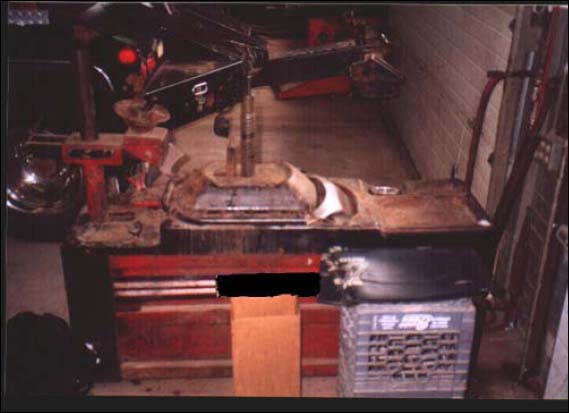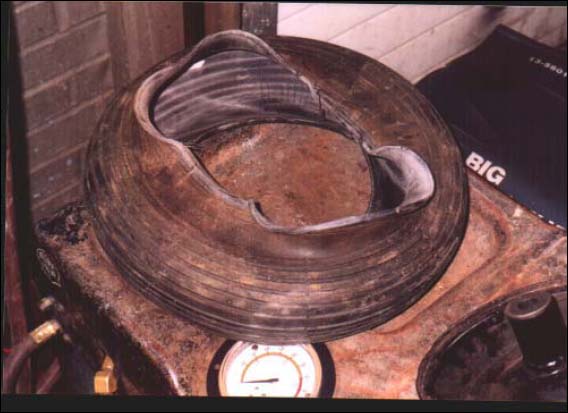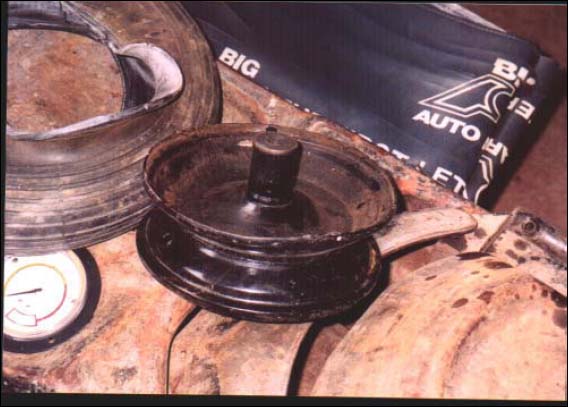|
 |
U. S. Department of Labor
Occupational Safety and Health Administration
Directorate of Science, Technology and Medicine
Office of Science and Technology Assessment
|
Hazards while Servicing Light Truck, Automobile, and Other Small Tires
|
|
Safety and Health Information Bulletins |
|
|
SHIB 04-29-2004 |
|
This Safety and Health Information Bulletin is not a standard or regulation, and it creates no new legal obligations. The Bulletin is advisory
in nature, informational in content, and is intended to assist employers in providing a safe and healthful workplace. The Occupational Safety
and Health Act requires employers to comply with hazard-specific safety and health standards. In addition, pursuant to Section 5(a)(1), the
General Duty Clause of the Act, employers must provide their employees with a workplace free from recognized hazards likely to cause death or
serious physical harm. Employers can be cited for violating the General Duty Clause if there is a recognized hazard and they do not take
reasonable steps to prevent or abate the hazard. However, failure to implement any recommendations in this bulletin is not, in itself, a
violation of the General Duty Clause. Citations can be based only on standards, regulations, and the General Duty Clause. |
Purpose
The purpose of this Safety and Health Information Bulletin (SHIB) is:
- To alert service stations and other tire repair shops of the hazards associated with the repair or service of light truck, automobile,
and other small tires;
- To encourage employers to establish proper service and repair procedures; and
- To encourage employers to provide training and enforce the procedures established.
Background
The Hartford Area Office has investigated several serious injuries and one fatality that occurred during the servicing of automobile and
other small tires. The accidents occurred while employees were attempting to repair or service mismatched tires and rims. All the accidents
resulted in employees sustaining severe head and arm injuries when the tire ruptured with explosive force. The pictures in this SHIB
graphically portray the results when attempting to repair or service mismatched tires and rims.
OSHA standard 29 CFR 1910.177, Servicing multi-piece and single piece rim wheels, applies only to the servicing
of multi-piece and single piece rim wheels used on large vehicles such as trucks, tractors, trailers, buses, and off-road machines. It does
not apply to the servicing of rim wheels used on automobiles, or on pickup trucks, and vans utilizing automobile tires or truck tires
designated “LT”.
Description of Hazard
During the servicing or repair of automobile, light truck, and other small tires, employees use pressurized air to correctly position the
tire against the rim flange. This procedure is referred to as “seating the bead.” The tire bead is the inner edge of the tire that contacts
the wheel flange and presses against the bead seat. The danger of serious injury or death is present if a tire of one bead diameter is
installed on a rim or wheel of different rim diameter. While it is possible to pass a 16" diameter tire over the lip or flange of a 16.5"
size diameter rim, it cannot be inflated enough to position itself against the rim flange. If an attempt is made to seat the tire bead by
inflation, the tire bead could break with explosive force. The hazard is present if an employee tries to install a tire on the incorrect
diameter rim or is attempting to inflate or service a tire that is already mounted on an incorrect rim. This can be especially hazardous
if an employee attempts to repair or inflate a tire that is not properly secured to a tire mounting machine, the vehicle, or in a safety cage.
Recommendations
Follow tire manufacturers’ procedures and recommendations during the servicing and repair of automobile, light truck, and other small
tires. Tire servicing procedures should include:
- Never attempt to install a tire of one bead diameter on a rim or wheel of a different rim diameter. The tire size is molded into the
sidewall of the tire.
- Follow the owner’s manual instructions or tire placard instructions located on the vehicle. Only inflate tires to the recommended proper
inflation pressure. Tires should not be inflated above the maximum pressure recommended by the manufacturer to seat the tire bead firmly
against the rim flange.
- Never inflate a tire unless it is securely mounted to the tire mounting machine, the vehicle, or in a safety cage.
- Although the scope of 29 CFR 1910.177, Servicing multi-piece and single piece rim wheels, does not apply during servicing and repair of
automobile, light truck, and other small tires, the standard contains useful information that could be used to protect personnel from the
hazards described in this document. The standard, found at
http://www.osha.gov/pls/oshaweb/owadisp.show_document?p_table=STANDARDS&p_id=9825 contains information that may assist the employer in
establishing service and repair procedures and training of employees. One useful method is the use of a safety cage or rack that could be
used as a restraining device when inflating the tires.
- Establish proper tire service, repair and inflating procedures and train employees to follow these procedures.
- Communicate and enforce these procedures.

Tire Mounting Machine
|

Picture depicting damage to tire that occurred during attempt to inflate a mismatched tire and rim
|

Picture depicting damage to tire and rim |
|
|

